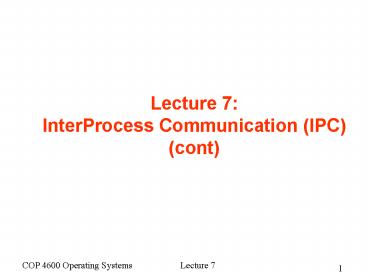Lecture 7: InterProcess Communication IPC cont - PowerPoint PPT Presentation
1 / 20
Title:
Lecture 7: InterProcess Communication IPC cont
Description:
Race Conditions: two or more processes are reading and writing on shared data ... Mutual exclusion : making sure that if one process is ... Unlocked (0) ... – PowerPoint PPT presentation
Number of Views:90
Avg rating:3.0/5.0
Title: Lecture 7: InterProcess Communication IPC cont
1
Lecture 7 InterProcess Communication (IPC)
(cont)
2
Inter-process Communication (IPC)
- Definitions
- Race Conditions two or more processes are
reading and writing on shared data and the final
result depends on who runs precisely when - Mutual exclusion making sure that if one
process is accessing a shared memory, the other
will be excluded from doing the same thing - Critical region the part of the program where
shared variables are accessed
3
Requirements for Correct Mutual Exclusion?
4
Mutual Exclusion
- Four conditions to provide CORRECT mutual
exclusion - No two processes simultaneously in critical
region - No assumptions made about speeds or numbers of
CPUs - No process running outside its critical region
may block another process - No process must wait forever to enter its
critical region
5
Mutual Exclusion Your Ideas?
6
Mutual Exclusion
- Idea 1 Disabling Interrupts
- Busy waiting testing a variable until some value
appears - Idea 2 Lock Variables
- Idea 3 Strict Alternation
- Idea 4 Petersons
- Idea 5 Test and Set Lock
- Sleep and wakeup
- Semaphores, mutexes
- Monitors
- Message passing
7
Mutual Exclusion with Busy Waiting Idea 2 Lock
Variables
- A lock that uses busy waiting is called a spin
lock - A single shared lock variable (lock) initially 0
- When a process wants to enter its critical region
- Check if the lock is 0
- If lock 0 then set it to 1 and enter the
critical region, set it back to 0 before leaving
the critical region. - If lock 1 then wait until it is set to 0
- Does the above scheme work?
8
Mutual Exclusion with Busy Waiting Idea 3
Strict Alternation
- Process 0.
Process 1.
Initially turn 0
9
Mutual Exclusion with Busy Waiting Idea 3
Strict Alternation
- Process 0.
Process 1.
- Scenario
- Process 0 leaves critical region, sets turn to 1,
enters non critical region - Process 1 enters critical region, sets turn to 0,
and leaves critical region - Process 1 enters non-critical region, quickly
finishes its job and goes - back to the while loop
- Since turn is 0, process 1 has to wait for
process 0 to finish its non-critical region so
that it can enter its critical region - This violates the third condition of providing
mutual exclusion
10
Mutual Exclusion with Busy WaitingIdea 4
Petersons Solution
- Wait until the other process sets the turn
while (turn process) - Wait while the other process is interested
while (interestedotherTRUE) - Go out of the while loop after the other process
has left its critical region
11
Mutual Exclusion with Busy Waiting Idea 5 TSL
Instruction
- TSL (Test and Set Lock) instruction is provided
by the hardware - TSL REGISTER, LOCK reads the contents of the
lock into REGISTER and sets LOCK to 1 in an
atomic fashion - No other processor can reach LOCK during TSL
- In order to achieve that, CPU executing TSL
instruction locks the memory bus to prevent other
processors accessing LOCK
12
Mutual Exclusion with Busy Waiting
- Causes a problem called PRIORITY INVERSION
- Two processes H (high priority) and L (Low
Priority) - Scheduler must make sure that H is executed
whenever it is in ready state
- Scenario
- Process H blocks for I/O
- Process L now can execute and enters its critical
section - I/O operation H waits for is now complete
- H is scheduled now but since L is in the critical
section, H does busy waiting - But L is never scheduled while H is running
- And the system is blocked forever.
13
Study Case Producer Consumer Problem (bounded
buffer)
- Two processes producer and consumer that share a
fixed size buffer - Producer puts an item into the buffer
- Consumer takes out an item from the buffer
- PROBLEMS
- What happens when the producer wants to put an
item into the buffer while the buffer is already
full? - OR when the consumer wants to consume an item
from the buffer when the buffer is empty?
14
Sleep and Wakeup
- Consumer is running
- It checks count when count 0
- Scheduler decides to run Producer just before
consumer sleeps - Producer inserts an item and increments the count
- Producer notices that count is 1, and issues a
wakeup call. - Since consumer is not sleeping yet, the wakeup
signal is lost - Scheduler decides to run the consumer
- Consumer sleeps
- Producer is scheduled, which runs N times, and
after filling up the buffer it sleeps - Both processes sleep forever (or until the OS
comes and sends a kill signal to kill both)
15
Solution Semaphoresby Dijkstra (1930 2002)
- Born in Rotterdam, The Netherlands
- 1972 recipient of the ACM Turing Award (Nobel
Prize for computing) - Responsible for
- The idea of building operating systems as
explicitly synchronized sequential processes - The formal development of computer programs
- Best known for
- His efficient shortest path algorithm
- Having designed and coded the first Algol 60
compiler. - Famous campaign for the abolition of the GOTO
statement - Also known for his hand-written communications
with friends and colleagues. For example
http//www.cs.utexas.edu/users/EWD/ewd12xx/EWD1205
.PDF
16
Solution Semaphores
- A semaphore can be
- 0 when no wakeups are present
- gt 0 when there are pending wakeups
- Two atomic operations on a semaphore
- Down checks the value of the semaphore
- If value is gt 0, then it decrements it (by using
one wakeup signal) and continues - If value 0, then the process is put to sleep
without completing its down operation - Up increments the value of the semaphore
- If there are processes sleeping on the semaphore,
then one of them is chosen, and it is allowed to
complete its down operation - Checking the value of a semaphore and updating
them is done in an atomic fashion - Disabling interrupts when one CPU exists or TSL
instruction could be used when multiple CPUs exist
17
Semaphores
- The producer-consumer problem using semaphores
18
Mutexes
- Simplified versions of semaphores
- Variable that can be in one of two states
- Locked (1)
- Unlocked (0)
- When a thread (or process) needs access to a
critical region, it calls mutex_lock() on a mutex - While leaving the critical region it calls
mutex_unlock() - If a mutex is already in locked state, then the
thread calling the mutex_lock() on that mutex
blocks - When a thread calls mutex_unlock, then one of the
threads blocked on the mutex is unblocked and
allowed to acquire the lock.
19
Mutexes
- Implementation of mutex_lock and mutex_unlock
using TSL instruction
20
Producer/Consumer Problem with Semaphores
What happens when we do a down on mutex first in
the producer function?































